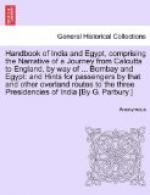* * * * *
Occasionally, when the prayer-breath of the ordinary worshipper has failed to effect a cure, a Mussulman mother will take her sick child to some Syed or other holy man in the city for what she calls “Jhada dalwana” (i.e. the sweeping-over). The Syed questions her about the symptoms and duration of the disease. “Ay me,” moans the mother, “I cannot say what ails the child, Syed Saheb! He was full of life and health till the other day when I left him on the threshold sucking a sweetmeat. There came by an old Wagri woman who stared at him, whining for alms. I gave her a little bread, wishing her well away: but alack! no sooner had she gone than my child sickened and hath not recovered since.” The Syed then asks her to drop a pice upon a paper covered with magic squares; which being done, he consults a thumb-marked manuscript and decides that the child is a victim of the Evil Eye. Accordingly he proceeds to pass the end of a twisted handkerchief seven times over the child’s body, murmuring at the same time certain mystic formulae which he, as it were, blows over the child from head to foot. This operation is performed daily for three or four days; after which in many cases the child actually gets better, and the mother in gratitude pays the Syed from eight annas to a rupee for his kind offices. So too it is the Syed and the prayers he breathes which exorcise the spirit of hysteria that so often lays hold of young maidens; and it is likewise the prayer-laden breath of the devout man which fortifies the souls of them that have journeyed unto the turnstiles of Night.
XII.
CITIZENS OF BOMBAY.
THE MEMON AND RANGARI.
[Illustration: A Bombay Memon.]
Would you learn how the Memon and the Rangari—two of the most notable inhabitants of the city—pass the waking hours? They are early risers as a rule and are ready to repair to the nearest mosque directly the Muezzin’s call to prayer breaks the silence of the approaching dawn, and when the prayers are over they return to a frugal breakfast of bread soaked in milk or tea and then open their shops for the day’s business. If his trade permits it, the middle-class Memon will himself go a-marketing, taking with him a “jambil” or Arab-made basket of date-leaves in which to place his vegetables, his green spices, his meat and a little of such fruit as may be in season. His other requisites,—flour, pulse, sugar and molasses,—come to him in what he calls his “khata,”—his account with a neighbouring retail-dealer. He is by no means beloved of the Bombay shop-keeper, for he is strict in his observance of the “sunna” which bids him haggle “till his forehead perspires, just as it did in winning the money”. The Bombay shop-keeper commences by asking an exorbitant price for his commodities; our Memon retorts by offering the least they could possibly fetch; and the battle between the maximum and the minimum eventually settles itself somewhere about the golden mean, whereupon the Memon hies him homewards as full of satisfaction as Thackeray’s Jew. In many cases the mother of the house or the sister, if old, widowed and in the words of the Koran “despairing of a marriage,” performs the business of shopping and proves herself no less adept than her kinsman at driving a bargain.




